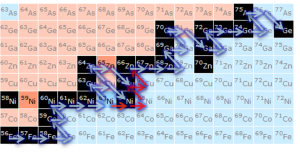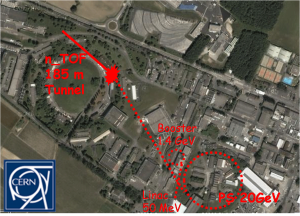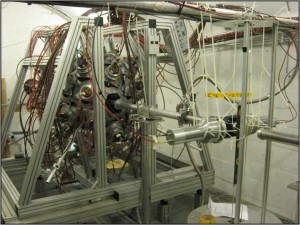Research lines
The Gamma Spectroscopy Group at IFIC is devoted to the investigation of several aspects of the structure of atomic nuclei and the applications of Nuclear Physics to related fields.
Neutron cross-sections measurements for astrophysics
The origin of the heavy elements in the Universe
Neutron induced reactions play a fundamental role in Nature. All elements heavier than iron are synthesized in the Universe by means of neutron capture reactions. Essentially two mechanisms are postulated to explain the abundances observed in our Solar System (SS), which are the slow (s) and the rapid (r) neutron capture processes, operating in giant stars and cataclysmic environments, respectively. The s-process is characterized by "slowness": one neutron capture per seed nucleus every 10^3-10^5 years!. Therefore, the s-process path follows the valley of beta-stability (see Fig. 1) and the final abundances are essentially tailored by the neutron capture cross sections of the stable nuclei. Some isotopes can be only produced by the s-process, because they are shielded from the r-process by their stable isobars. This is the case of 58Ni, 64Ni, 70Ge, etc (Fig.1).
 S-process nucleosynthesis takes place in two stages of the stellar evolution of giant stars, namely in low-mass thermally-pulsing Asymptotic Giant Branch (AGB) stars, and in massive stars. These are known as the main and the weak s-process components, respectively. Thermally pulsing AGB stars are characterized by the alternative activation of two neutron sources, during H-burning the 13C(α,n)16O reaction is activated at tempreatures of around 90MK (kT=8keV) and the 22Ne(a,n)25Mg contributes at 250 MK (kT=23keV). About 95% of the neutron exposure is due to the 13C(a,n) neutron source, which produces "only" about 10^7 n/cm^3. The remaining 5% corresponds to the contribution of the 22Ne(α,n) source during the recurrent thermal pulses, where much higher neutron fluences, of about 10^11 n/cm3 are achieved. In massive stars the s process takes place during two different evolutionary phases. First, during core He-burning neutrons are produced by the 22Ne(α,n)25Mg reaction at temperatures of 300 MK (kT=26keV) and neutron densities of only 10^6 n/cm3. Part of this s-process material is exposed to a second re-processing due to the 12C(12C,n)23Mg source during sell Carbon burning phase, which reaches much higher temperatures of 1 GK (kT = 91 keV) and neutron densities 10^11 n/cm3.
S-process nucleosynthesis takes place in two stages of the stellar evolution of giant stars, namely in low-mass thermally-pulsing Asymptotic Giant Branch (AGB) stars, and in massive stars. These are known as the main and the weak s-process components, respectively. Thermally pulsing AGB stars are characterized by the alternative activation of two neutron sources, during H-burning the 13C(α,n)16O reaction is activated at tempreatures of around 90MK (kT=8keV) and the 22Ne(a,n)25Mg contributes at 250 MK (kT=23keV). About 95% of the neutron exposure is due to the 13C(a,n) neutron source, which produces "only" about 10^7 n/cm^3. The remaining 5% corresponds to the contribution of the 22Ne(α,n) source during the recurrent thermal pulses, where much higher neutron fluences, of about 10^11 n/cm3 are achieved. In massive stars the s process takes place during two different evolutionary phases. First, during core He-burning neutrons are produced by the 22Ne(α,n)25Mg reaction at temperatures of 300 MK (kT=26keV) and neutron densities of only 10^6 n/cm3. Part of this s-process material is exposed to a second re-processing due to the 12C(12C,n)23Mg source during sell Carbon burning phase, which reaches much higher temperatures of 1 GK (kT = 91 keV) and neutron densities 10^11 n/cm3.
Measuring stellar rates in the laboratory
One of the most precise and complete techniques for measuring neutron capture cross sections over a broad energy range is the time-of-flight (TOF) method. In order to perform this kind of measurements the Gamma-Spectroscopy Group joined the CERN n_TOF Collaboration in 2000 and since then is actively involved in many (n,γ) measurements of astrophysical relevance. At n_TOF neutrons are produced by means of spallation reactions, when a very intense and 6 ns short pulsed proton beam (7x10^12 protons/pulse) impinges at 20 GeV/c on a lead target. The spallation process is a very prolific mechanism for neutron production, yielding around 300 neutrons per each incident proton. The experimental hall is located at 185 m from the spallation source in order to achieve a very good neutron energy resolution.

View of the CERN region where n_TOF is located. The dashed lines represent schematically the proton accelerator complex used.
Neutron capture cross sections are measured by detecting the cascade of prompt gamma-rays which follow each neutron capture event. To this aim two different detection systems are commonly used at CERN n_TOF, a Total Absorption Calorimeter (TAC) and a set-up of two C6D6 liquid scintillation detectors.
The TAC is composed of 40 BaF2 scintillation crystals building a spherical shell around the sample under study. The very high efficiency of TAC, nearly 100%, allows to perform accurate measurements in relatively short periods of time, thus optimizing also the beam-time needed for such experiments.
Another detection system extensively used at n_TOF is a set-up of two C6D6 liquid scintillation detectors. This is particularly useful for the measurement of very low neutron capture cross sections, where typically the neutron elastic channel dominates (sometimes by orders of magnitude) with respect to the capture channel of interest. In those cases, low-efficiency C6D6 detectors are much less sensitive to background events induced by scattered neutrons. At n_TOF we have developed special C6D6 detectors optimized for very low neutron sensitivity[Plag03]. To this aim, structural materials such as the common photomultiplier housing, were removed, and others were replaced by carbon fiber. C6D6 detectors are able to register at most one of the cascade gamma-rays, which requires the use of the so-called Pulse Height Weighting Technique[Macklin67]. One of the first R+D activities of n_TOF was to validate the experimental technique (PHWT) and to determine the sytematic accuracy that can be achieved with this method. At the Gamma-Group of IFIC we developed detailed Monte-Carlo simulations, which in combination with dedicated (n,g) measurements at n_TOF on various samples of 56Fe, 107Ag and 197Au demonstrated that the uncertainty that can be achieved with the PHWT is better than 2%. This fulfils the needs of stellar nucleosynthesis studies, that typically require cross sections with uncertainties <4%. This work was published in [Abbondanno04] and is described in this PhD-Thesis.

Picture of the CERN n_TOF experimental area. On the left-hand side the BaF2 Total Absorption Calorimeter. On the right-hand side the set-up of two C6D6 detectors.
Once the technique was validated and the experimental effects well under control, we applied it at n_TOF in order to determine the (n,g) cross section of several isotopes of astrophysical relevance. One of the very first experiments was the neutron capture measurement of the unstable isotope 151Sm (t1/2=90y). 151Sm is a branching point nucleus along the main s-process path and its b-decay half-life shows a very strong temperature dependence. By measuring its neutron capture cross section over the stellar energy range of interest, one can thus derive unvaluable information about the physical conditions inside red giant stars, where this nucleosynthesis takes place.
To learn more about the present research activity of the group in this field you can check https://hymnserc.ific.uv.es.